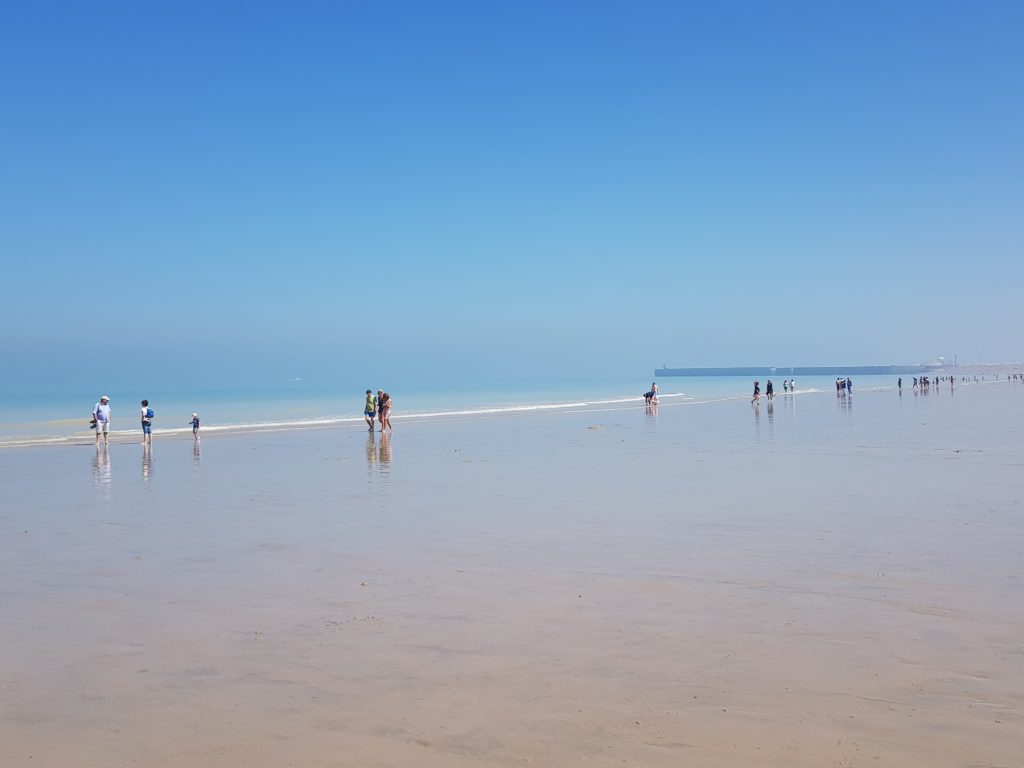
The Normandy coast offers 620 kilometres of beaches for those who love the sea. The coastline along the English Channel is more diverse and varied than in almost any other region in France: among the most beautiful beaches in Normandy are natural tidal landscapes as well as bays in the middle of the cliffs, lively city beaches, the wide beaches of the fashionable seaside resorts and the historic landing beaches.
La plage d’Étretat
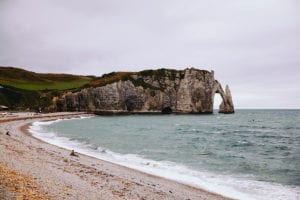
Étretat is one of the beaches in France with the most exceptional panorama. Known for its high cliffs, where a wide beach lies between the chalk cliffs “Falaise d’Aval” and “Falaise d’Amont”, the cliffs offer several postcard motifs. Anyone who has seen enough of the “Porte d’Aval” and “Manneporte” arches from a distance should climb the rocks and enjoy the view from the cliffs of the steep coast.
The natural monuments are connected by hiking trails – to enjoy the full splendour of Étretat, you should pack sturdy shoes and a camera. For bathing, Étretat takes some getting used to. The beach consists of many coarse pebbles, parts of the chalk cliffs that the wind and the sea have eroded over time. By the way, it is forbidden to pick up the stones, they are too important as mini breakwaters to protect the coast.
La plage d’Antifer – Le Tilleul
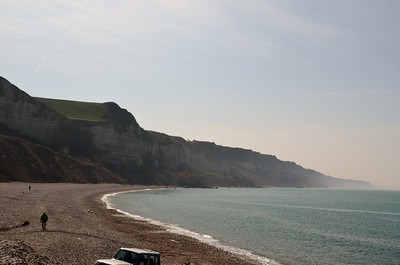
What makes the beach Plage d’Antifer, also called “Le Tilleul” after the nearest village – so special is the wonderful view of the cliffs of Étretat on the right and the headland of Fourquet on the left. The panorama creates a unique atmosphere. The view combined with the fact that the beach is comparatively remote and unspoilt make the Plage d’Antifer an extremely attractive destination, especially for adventurous Normandy holidaymakers. The beach itself is pebbly, but the sandbanks hidden at high tide are soft and can be discovered on foot as soon as the water has receded.
From the nearest (free) car park, it is 2 kilometres to the waterline. Beware: the last stretch leads down from the cliff and is a bit of a challenge. However, it is worth the effort; once you reach your destination, one of the most beautiful beaches in Normandy awaits you.
Les plages de Deauville et Trouville
Part 1 – Deauville
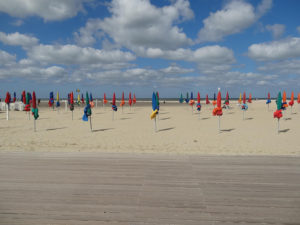
The “endless” beach of the once fashionable seaside resort of Deauville is a real attraction. The sand is white and fine, the view goes far out to sea and cooling off on a hot day in the relatively cold water means real refreshment. Despite its fame, the beach is not permanently overcrowded even in the summer season; visitors spread out over the wide area.
What distinguishes the beach of Deauville from other beaches and makes it so famous is the surrounding area. Over 650 metres of wooden planks form a wide promenade for strolling. Also worth seeing are the Art Deco-style pools and changing rooms at the head of the beach, some named after actors. Even though the wind can be quite strong in autumn and winter, it’s worth visiting Deauville beach at any time of year!
Part 2 – Trouville-sur-Mer
The fact that Trouville-sur-Mer, in contrast to neighbouring Deauville, is the older and organically grown town is hardly noticeable today. Above all, the beach belonging to Trouville-sur-Mer is not noticeably different from its neighbouring counterpart, which officially belongs to Deauville. The Grand Plage de Trouville also seems to be lost in infinity. This beach is also a magnet for visitors, not only because of the fresh air, but also because of the architecture of the surrounding villas and houses. Here, too, the nostalgic-characteristic changing cabins are popular photo motifs. And here, too, many restaurants, bars and cafés offer gastronomy in every price range.
Even though it may be less bourgeois and exclusive nowadays than in the heyday of the double resort of Deauville-Trouville around the turn of the 20th century, the special flair of the two beaches of Deauville and Trouville, which can still be felt, make a stop here a must during a holiday in Normandy.
Plage d’Hermanville – Hermanville-sur-Mer (Calvados)
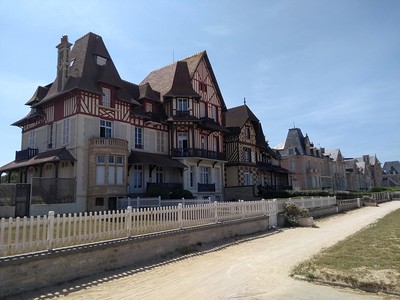
Hermanville-sur-Mer has a long sandy beach typical of Normandy. The stretch of seafront stretches for almost 2 kilometres between Lion-sur-Mer in the west and Ouistreham beach in the east.
Architecturally attractive villas from the Belle Epoque of the French Channel coast at the end of the 19th century line the inviting promenade. Among the most famous buildings is the Villa La Bluette, unmistakable by its blue-painted wooden beams amidst the brickwork and the equally blue fence.
In summer, the Plage d’Hermanville is well frequented; Caen, only 20 minutes away by car, sends its residents and guests to the sea here. Nevertheless, there are parking spaces near the beach even in high season, for example in Avenue Coty or Avenue Faure.
The beach of Hermanville was also a landing beach during D-Day 1944. Monuments in the town and on the beach as well as the “Musée du mur de l’Atlantique” in neighbouring Ouistreham commemorate the events on “Sword Beach”.
Hauteville-sur-Mer
Hauteville-sur-Mer radiates a great deal of tranquillity; the town not far from Coutances is not overrun with visitors even in the best tourist season. Hauteville is also a suitable holiday destination for sports enthusiasts, who will find plenty of opportunities to pursue their passions at and on the sea.
The seaside resort has several beaches to offer. The section of coast closest to the town centre is covered with water up to the quay wall at high tide, while the sea recedes very far at low tide. For walks and also for bathing, the beach of the sailing school in the south of Hauteville-sur-Mer is more recommended. Here, access is possible at any level of the water. The beach is guarded in summer, and you can take sailing courses or hire a kayak at the Centre Nautique.
A big plus for camping enthusiasts: there are four campsites in the immediate vicinity of the water.
Barneville-Carteret
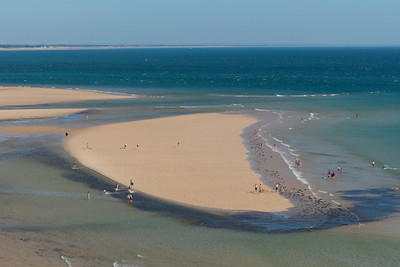
One of the most beautiful beaches on the Cotentin peninsula in western Normandy belongs to the village of Barneville-Carteret. “Grande Plage de Barneville” is the official name of the beach for a reason: the fine sandy section is clean, spacious and even in summer there is still enough room for everyone to enjoy the sea. Especially for families, Barneville is therefore as popular as it is recommendable.
The west-facing beach always offers an exceptional view. At any time of day, on a clear day, you can see the Channel Islands of Jersey and Guernsey. The sunsets at the Grand Plage are particularly impressive – whatever the weather.
Baie de Mont Saint-Michel
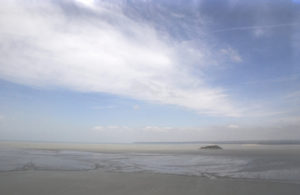
The stretch of coast in front of the world-famous monastery island of Mont Saint-Michel is not a bathing beach. The tide flowing back from the sea returns in the immediate vicinity of the island at high speed (although not with the speed of a galloping horse, as is occasionally erroneously reported), so that even those who take in the landscape on a walk have to be extremely careful.
But even if you can’t bask in the sand under the sun here, the beach is one of the most impressive landscapes on the Normandy coast and in France as a whole. It is not for nothing that UNESCO has declared the landscape a World Heritage Site. On the Breton side of the Bay of Mont Saint-Michel are some of the most beautiful beaches in Brittany. The Plage du Sillon in Saint-Malo, for example, is a stretch of coastline that offers the perfect beach experience – bathing included.
Le Havre
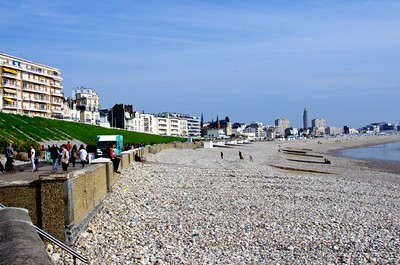
Le Havre is not a seaside resort, and other beaches in Normandy are more pleasant for swimming or lying in the sand. Nevertheless, the Plage de Le Havre belongs to the list of the most beautiful beaches of the department on the English Channel.
The 4-kilometre-long promenade is a wonderful place to stroll, with the busy sea and the many ships entering the city’s harbour on one side and the architecturally remarkable centre on the other.
As the end point and/or retreat of an extended stroll through Le Havre, there is no nicer setting. Picnics for all and playgrounds for the kids – what more could you want?
Surfing, water skiing, canoeing, skating (at the largest free outdoor skate park in France), jogging, beach volleyball: there are few sporting activities you can’t do here.
The beach is clean, but don’t forget the pebbles. During the season, the Plage de Le Havre is supervised and partially barrier-free. Showers and changing rooms are open for free use.
An abundance of restaurants and bars leaves no culinary wish unfulfilled. And: Le Havre beach is probably the only beach in Normandy that can be reached by tram!
Arromanches-les-Bains
The beach at Arromanches-les-Bains is a very special part of the Normandy coast. In June 1944, the beach was at the centre of the Allied landings in France. The seaside resort was an important target for the Allied troops, who wanted to create an artificial harbour here to supply the armies with weapons and ammunition.
As a reminder against war and tyranny, the remains of the temporary harbour on the former landing beach can still be seen today. In the town itself, the “Musée du Débarquement” museum and the “Arromanches 360” cinema provide intensive insights into the events surrounding D-Day.
L’Anse de Vauville

In extreme contrast to the urban beaches around the mouth of the Seine, the beach near the town of Vauville promises a pure nature experience. The long bay “L’Anse de Vauville” is located on the west side of the Cotentin peninsula, opposite the islands of Guernsey and Jersey.
10 kilometres of beach, bordered by high cliffs in the south and north (some of them are among the highest in Europe at up to 128 metres!), await nature lovers here. Directly adjacent to the broad strip of sand is a marsh/dune landscape in which isolated villages lie, such as the eponymous Vauville. The village has 300 inhabitants, a two-star campsite and a pizzeria, and sights such as the “Fort” and a “Jardin exotique”.
The plants have extremely stable conditions here; there are not few areas in Europe where the temperature differences between the seasons are so small. For holidaymakers, this means that it rarely gets really hot here, even in summer. And that is also part of the truth: if you are unlucky, it often rains. But it is precisely the inhospitable at first impression that is the secret of the Anse de Vauville. Anyone who can connect with this Normandy landscape will find it wonderfully undisturbed.
Images:
Plage de Dieppe (oben): © B. Collier – CRT Normandie
Étretat: © Cristian Bortes | CC BY 2.0
Plage d’Antifer: © isamiga76 | CC BY 2.0
Deauville: © Elen Nivrae | CC BY 2.0
Mont Saint-Michel: © Katja Wagner | CC BY 2.0
Hermanville: © patrick janicek | CC BY 2.0
Barneville-Carteret: © Thomas Letournel | CC BY 2.0
Plage de Dieppe (unten): © Frédéric BISSON | CC BY 2.0
Le Havre Plage: © dominique Bernardini | CC BY 2.0
Plage Anse de vauville: © Daniel Jolivet | CC BY 2.0
